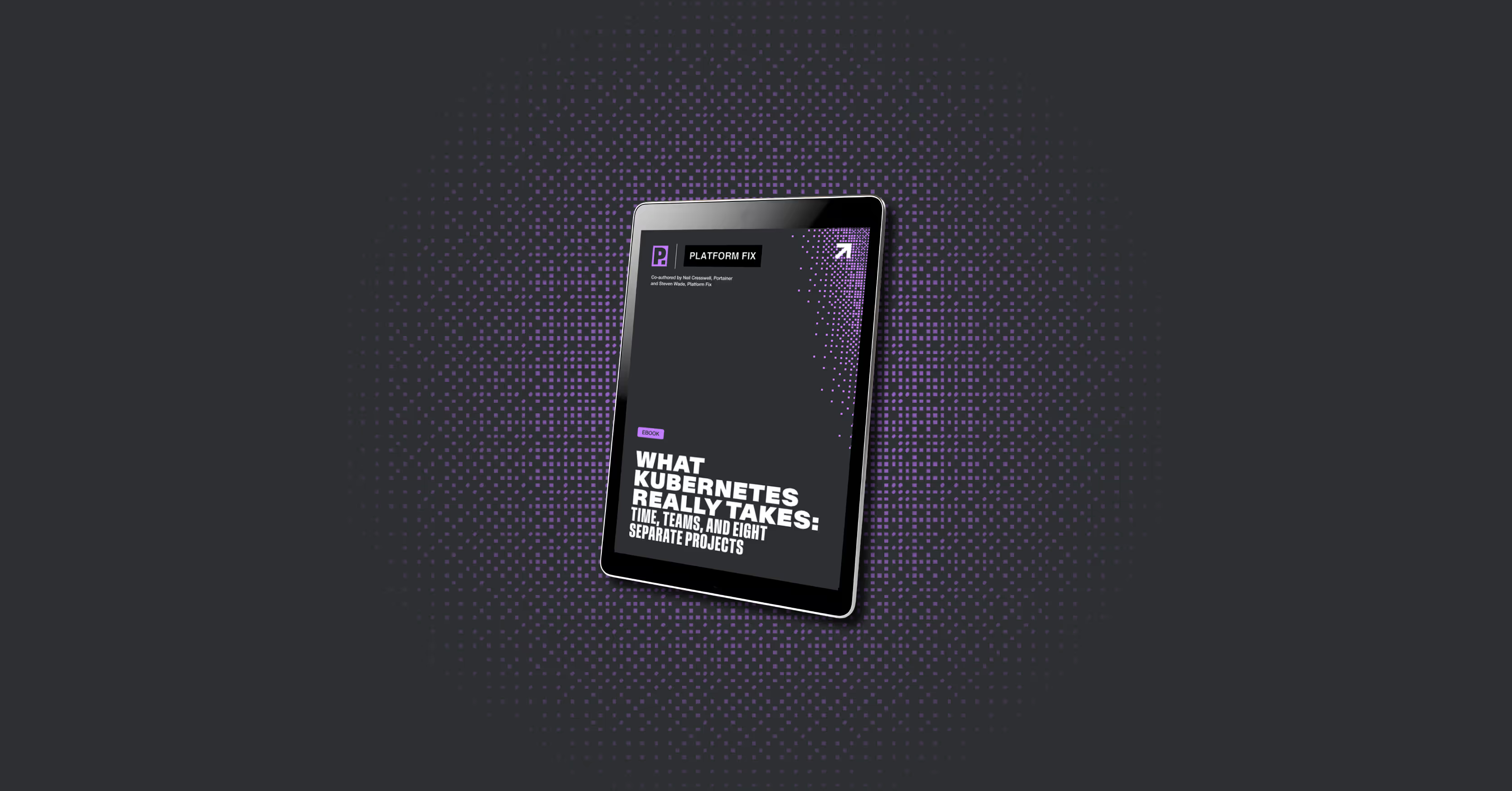Kubernetes adoption is rarely the tidy, single-track “modernization project” it’s sold as. In reality, it’s a complex transformation made up of eight interconnected initiatives, each substantial enough to stand as its own program of work. These projects span everything from refactoring legacy applications and standardizing the container supply chain to implementing zero trust networking and building an internal developer platform. This Q&A distills the detailed insights from the What Kubernetes Really Takes whitepaper into practical, technically grounded answers for the most common questions teams face when planning, executing, and sustaining a Kubernetes transformation. Each answer is rooted in proven patterns, specific technology examples, and the realities of running Kubernetes at enterprise scale, whether you build your own software, deploy COTS applications, or work with outsourced development teams.
The Big Picture
1. Why do Kubernetes projects often go over budget?
Kubernetes initiatives frequently exceed budgets because organizations underestimate the scope. They think they’re deploying a single platform, but in reality, they’re launching eight parallel, high-effort projects. Each demands its own budget, resources, and expertise: from application refactoring to zero trust networking.
2. Why do timelines stretch far beyond initial estimates?
Timelines balloon when the interdependencies between the eight projects become clear. Application readiness delays platform operations, CI/CD rework delays deployments, and security enforcement can stall workloads. The recommended six-month implementation often becomes 18 months or more, particularly when unplanned work (such as rewriting vendor manifests) emerges.
3. What’s the biggest misconception about Kubernetes adoption?
The most damaging misconception is that Kubernetes is simply a container orchestrator you “stand up” and move workloads into. In practice, it’s a full operating model change, redefining how you build, secure, deliver, and observe software. It’s less about installing a cluster and more about transforming the way your IT organization operates.
4. Is Kubernetes a single project or multiple projects?
It’s eight projects “wearing a trench coat” and pretending to be one. The eight are:
- Refactoring legacy/COTS apps,
- Standardizing container builds,
- Designing and operating the platform,
- Rebuilding CI/CD for GitOps,
- Implementing zero trust networking
- Building observability,
- Adopting everything-as-code, and
- Platform engineering.
5. How does Kubernetes adoption affect organizations that don’t develop their own software?
The complexity is just as high for COTS-based or outsourced development shops. Vendor applications often aren’t packaged for Kubernetes, and outsourced teams may deliver code in incompatible formats. Contracts and SLAs must be rewritten to require containerization, compatible manifests, and observability hooks.
The Eight Projects
6. What is application refactoring and why is it needed before Kubernetes?
Application refactoring involves modifying legacy software so it can run in containers. This can mean breaking monoliths into smaller services, externalizing state, removing hardcoded IPs, or adding health probes. Without this, apps fail to deploy cleanly in Kubernetes. Even vendor apps often need manifest rewrites or privilege isolation.
7. How does COTS software complicate Kubernetes adoption?
COTS software can be shipped as outdated images, insecure manifests, or require elevated privileges that violate your cluster policies. Some lack Helm charts or provide charts assuming full-cluster admin rights. All of these require remediation before production deployment.
8. What is the “container supply chain” and why does it need governance?
The container supply chain is the end-to-end process of building, scanning, signing, and storing images. Governance is critical: define base images, enforce Dockerfile linting (Hadolint), sign images (cosign), scan for CVEs (Trivy, Grype), and use secured registries (Harbor, AWS ECR). Without governance, drift and security risk quickly accumulate.
9. What’s involved in designing and operating a Kubernetes runtime platform?
Beyond provisioning a cluster, platform operations include tenancy models (single vs multi-cluster), authentication (SSO, RBAC), networking (CNI plugins like Calico, ingress controllers like NGINX), storage (CSI drivers, snapshot policies), upgrades, and disaster recovery planning. The cluster must be treated as a product, not a tool.
10. How does Kubernetes change CI/CD pipelines?
Traditional pipelines deploy binaries to VMs. Kubernetes requires building container images, storing them in registries, and deploying via declarative manifests. GitOps tools (Argo CD, Flux) shift delivery from push to pull. Repo structures, secret management, and promotion workflows all require re-engineering.
11. What is GitOps and why is it important?
GitOps uses Git as the single source of truth for cluster state. Tools continuously reconcile what’s declared in Git with what runs in the cluster. This enables consistent, auditable, and reversible deployments; critical for scaling Kubernetes operations.
12. How does zero trust networking apply to Kubernetes?
By default, all pods can talk to each other. Zero trust applies explicit policies (via NetworkPolicies, Calico, Cilium) to control communication, adds service identity and mTLS (Istio, Linkerd), and secures ingress with TLS termination, rate limiting, and IP filtering.
13. What’s different about observability in Kubernetes environments?
Workloads are ephemeral, so IP-based monitoring breaks. Kubernetes observability requires metrics (Prometheus), logs (Fluent Bit, Loki), and tracing (OpenTelemetry, Jaeger) that capture pod metadata and survive restarts. Vendor apps often need wrapping or synthetic probes to be observable.
14. Why is “everything-as-code” essential for Kubernetes success?
Everything-as-code eliminates manual drift, enforces consistency, and enables rollback. This covers infrastructure (Terraform), application config (Helm, Kustomize), secrets (SOPS, Sealed Secrets), and policies (OPA, Kyverno). Git becomes the production source of truth.
15. What is platform engineering and why is it critical?
Platform engineering makes Kubernetes usable for humans. It delivers golden templates, internal CLIs, portals (Backstage, Portainer), documentation, and paved paths for developers. Without it, adoption slows, consistency drops, and the platform team drowns in support tickets.
Risks and Pitfalls
16. What are the hidden risks of treating Kubernetes as a simple deployment?
The biggest risks are incomplete security, poor developer adoption, operational fragility, budget blowouts, and staff burnout. These stem from ignoring the full scope of the eight projects and treating Kubernetes as “just” a platform install.
17. How does parallelizing all eight projects lead to failure?
Running all eight projects simultaneously overwhelms teams, introduces dependency deadlocks, and creates half-finished implementations. The result is stalled adoption, rising costs, and no working end-to-end path.
18. What are the talent and retention risks in Kubernetes projects?
Kubernetes projects without clear planning lead to burnout. Engineers spend months firefighting half-built systems, which drives attrition. Losing key staff mid-project compounds delays and cost overruns.
19. Why do COTS manifests and Helm charts often cause security issues?
Vendor-supplied charts often assume excessive privileges, use outdated base images, or bypass network policies. Without auditing and rewriting, these open vulnerabilities in production.
20. How can “conference-driven platform design” derail a Kubernetes initiative?
Copying tool choices from conference talks, without considering organizational readiness, leads to bloated toolchains and unnecessary complexity. The whitepaper warns against adopting dozens of CNCF tools “because everyone else uses them”.
Success Patterns
21. What does “slow is smooth, smooth is fast” mean in Kubernetes adoption?
It means that by progressing deliberately (completing one project at a time) you actually reach stability and value faster. Attempting everything at once leads to chaos and rework.
22. How should you sequence the eight projects for maximum success?
Begin with containerizing a non-critical application, then standardize your supply chain, then bring up a basic cluster, then rework CI/CD for GitOps, and so forth. Each completed project becomes a foundation for the next.
23. How can early wins build executive support?
A stable, production-ready workload (even if small) proves the approach works, builds trust, and unlocks further budget. This political capital is essential for the later, more complex projects.
24. What’s the role of political capital in Kubernetes adoption?
Political capital (earned by delivering early successes) shields teams from premature scope expansion and keeps executives committed through the longer transformation.
25. How can outsourced development teams be aligned to Kubernetes standards?
Include Kubernetes compatibility requirements in contracts: containerized deliverables, compliant manifests, observability hooks, and GitOps readiness. This avoids costly integration work later.
Executive-Level Considerations
26. How does Kubernetes change the IT operating model?
Kubernetes impacts how infrastructure is provisioned, how software is packaged, how it’s delivered, how it’s secured, and how it’s observed. It forces changes in team roles, processes, and governance.
27. What budget multipliers should be expected?
Expect 3–4x the initial budget and 2–3x the timeline once all eight projects are factored in. Ongoing operational costs can be 5–10x higher than running traditional workloads.
28. What is the long-term operational cost impact of Kubernetes?
Long-term costs rise due to the need for ongoing security patching, platform upgrades, observability maintenance, and developer enablement. These are recurring, not one-off, expenses.
29. How does Kubernetes adoption reshape team structures?
It often leads to the creation of dedicated platform engineering teams, changes in developer workflows, new security responsibilities, and closer integration between Dev, Ops, and Security.
30. What is the most important leadership mindset for Kubernetes success?
Leaders must see Kubernetes as an organizational transformation, not a technical upgrade. Success comes from sequencing, resourcing, and cultural change as much as from cluster configuration.
Kubernetes can absolutely deliver on its promises of portability, resilience, and scalability, but only if you recognize and plan for the eight distinct projects hiding beneath the surface. Treating it as a single deployment effort is the fastest way to overspend, overrun, and underdeliver. The answers here are a starting point, highlighting the most common complexities and considerations, but they only scratch the surface of what it takes to succeed. For a deeper dive into each project, complete with real-world examples, sequencing strategies, and detailed technical recommendations, explore the full What Kubernetes Really Takes whitepaper. It’s an essential read for anyone serious about leading a Kubernetes transformation without falling into the traps that stall so many initiatives.




